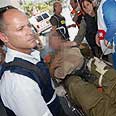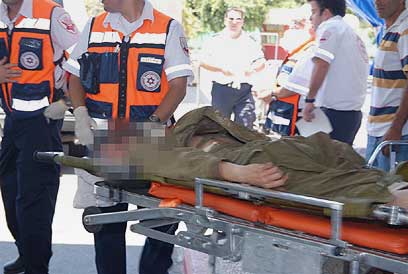
Pilot recounts rescue mission
Colonel S, one of the pilots who evacuated injured soldiers from battle in Bint Jbeil, tells of the difficult sights, exact operation, and heroism
He continued his work in Bint Jbeil, when he flew the Yanshuf (Owl) helicopter. "This was definitely one of the most dramatic operations," he recounted during a conversation with Ynet.
"When I went in, the place looked like a battlefield you see in the movies. A lot of smoke, burned houses, cars upside down. At that moment I ignored everything and concentrated on my mission," S. said.
After the difficult battle in which eight fighters from Brigade 51 were killed, and 22 injured, it was clear to officers who sat in the frontline command room of the Golani Division that the mission now facing them was the rescue of the injured soldier from the inferno.
In the first moments of the barrage of shots, it was clear that there was a need to land helicopters in Lebanese territory, and that this was the only way to bring the injured for treatment in Israeli hospitals.
"Shortly after 5 in the morning we received the first message on the incident and from that moment we began to prepare," Colonel S. recounted. "Actually, the fact that the IDF decided to transfer the injured to a distance of two kilometers from the battle zone allowed the air Force to prepare for an aerial rescue while the battle continued, and the first injuries were taken on stretchers to a place set as an improvised landing plan, in accordance with the operation's plans," S. explained.

Injured soldiers brought to hospital (Photo: Doron Golan)
In the first stage of the incident, only two Yanshuf choppers were ordered to land, but when the large number of casualties became apparent, five helicopters landed, with each one being on the ground for less than a minute.
'Not everything goes to plan'
The aerial convoy brought all of the injured to a medical center. "I know that everyone now is talking about how serious the incident was," said Colonel S. "And maybe there was a screw-up here or an error, but it must be remembered that not everything goes to plan," he said.
"We waited for many hours in the air and on the ground, and we planned in detail which crew will be working, how we will receive the injured, how we will organize ourselves better. I was the one who landed first, I focused only on my mission. I don't think there was any kind of effective fire on us, but I believe we were close to it. In such a situation you concentrate on the mission, you operate on automatic, and to get to such a situation you concentrate only on what is important, and your attention is not distracted sideways. This is the result of years of training," Colonel S. stressed.
He added that during the incident he did not know the identity of the injured who placed on the helicopter he piloted: "I have taken hundreds of injured throughout the years and I try not to know, I don't want to find out that I know someone or that I know their parents, I concentrate on my mission, and I leave the work for the medical crews."










